Six Things. In the Garden. On a Saturday.
I’ve been absent from my garden and from this Blog for a few weeks, and have come back to it with a somewhat new identity (different profile photo and new name). My sisters and I are planning a party early next year to celebrate our mother’s 90th birthday, and I was charged with creating the E-Vite “Save the Date” notice and invitation, and with setting up a website for it. These tasks have taken many hours of my time! I decided, of course, to set up the website on WordPress, assuming I would remember how to set one up since it’s only been a few months since I set up this blog for myself. Ha! One thing I know is that my eventual post-retirement job will NOT involve computer support or web page development!
You’d never know we got all that rain here earlier this summer, to look at my yard and garden now. A few “old faithfuls” are still alive and struggling to put forth blooms. But with no precipitation to speak of during the past hot month, and no supplemental watering from me, a lot died. I am pretty sure now that the yellow fig tree is dead, and will be cutting that down soon – maybe some pictures of that chore will make their way into a future “Six on Saturday” post. For more about this weekly challenge, visit The Propagator Blog for the Participant’s Guide and links to many gardener’s SOS postings each week.
My Six:
1. Beautyberries

Way off in the back of the garden, hidden behind the red (still living) fig, is a native shrub called beauty berry, or Callicarpa Americana. The shrub itself is not much to look at but the seed pods are quite nice, and tasty to the birds, I think.
2. Butterflies
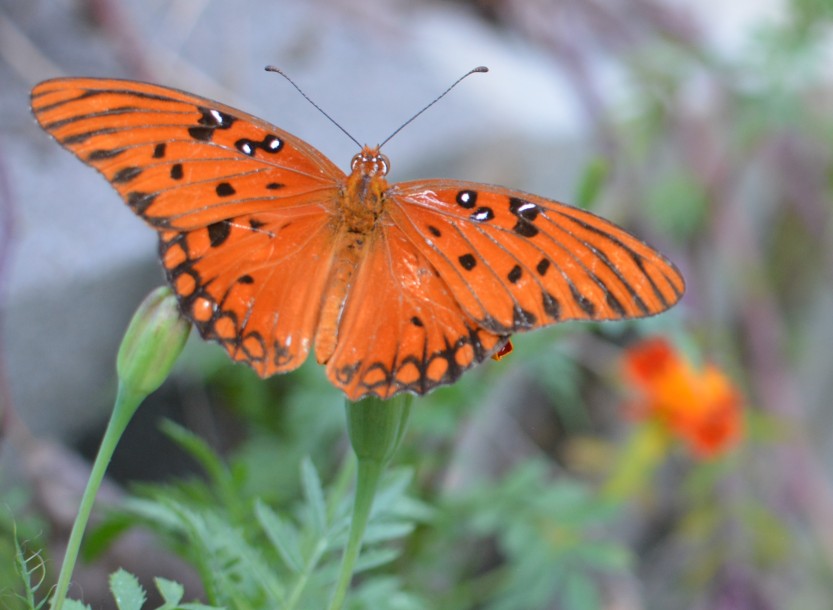
The butterflies are still here. We don’t have the variety that other gardeners post about (please, please visit The Propagator for links to other gardener’s Saturday postings – so many include gorgeous photos of incredible butterflies!) but our orange flowers – tithonia, marigolds, and zinnia – seem to attract and keep a lot of orange butterflies throughout the late summer.
3. Chia Sage
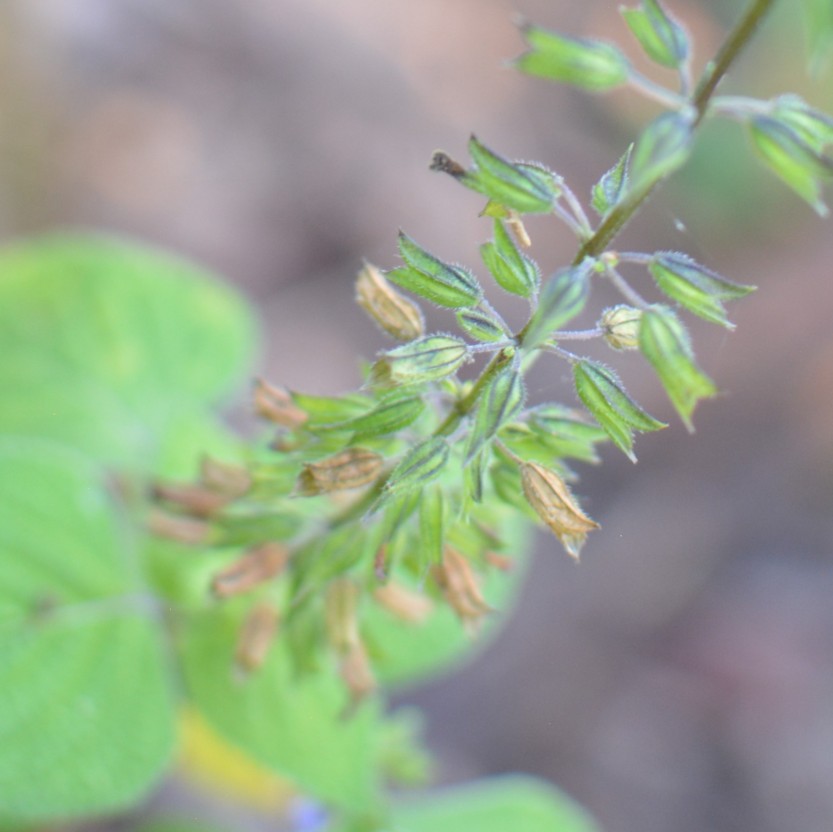
For the first time this year, I planted chia sage. Its leaves are fuzzy and almost succulent, the flowers were small but a pretty lavender, and I’m hoping that these little seeds will sprout in the spring and give me another reliable reseeding herb. I do not know whether this plant produces the same chia seed that is so popular now in beverages and smoothies. Even if so, it seems like I’d have to fill the entire garden with these plants to grow enough seeds to use for that.
4. Blue or Purple Aster
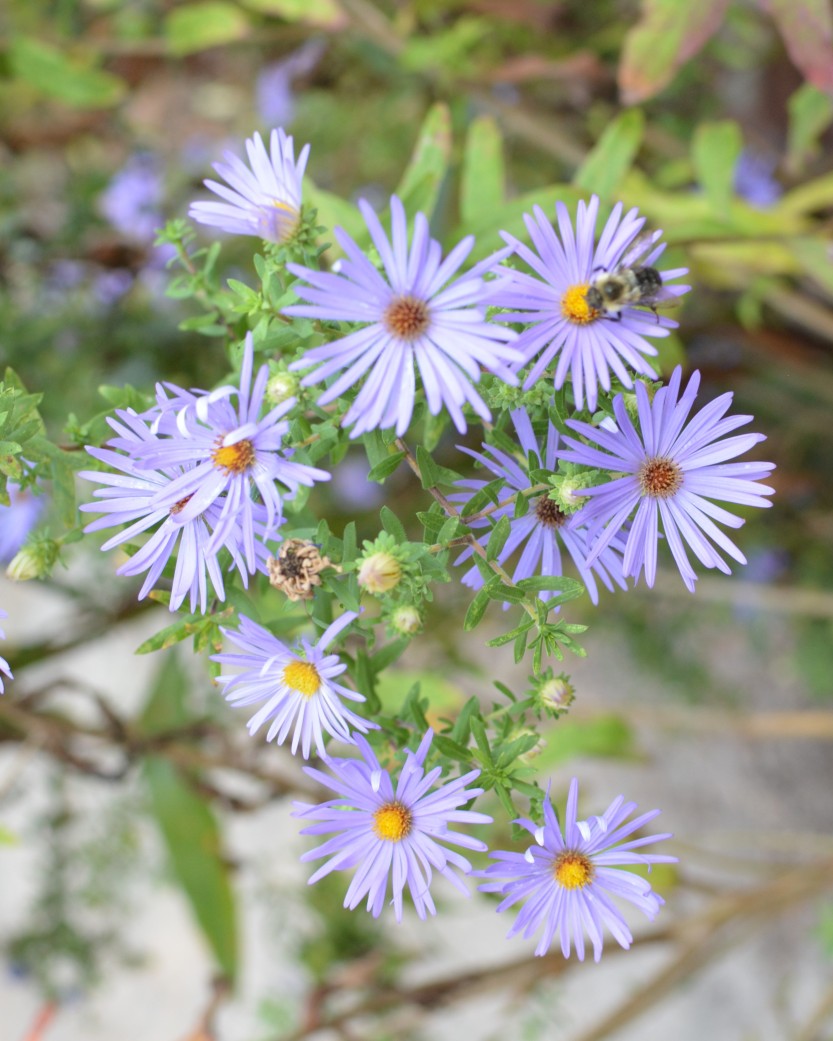
I should know the name of this aster, but I don’t remember it. The color of the flowers is something between a blue or a purple, depending on the light. This picture was taken in full sun and I think appears somewhat washed-out, lighter than what the color actually is. They are very pretty little flowers and attract bees, and sometimes also butterflies.
5. Tomato Pests
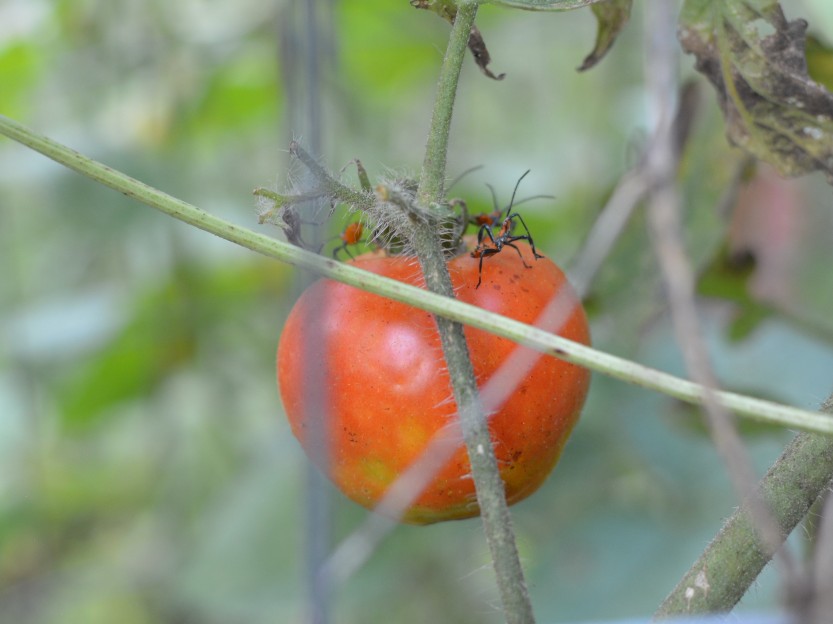
I don’t know what these little red and black bugs are on the tomato. Cute, though. Fortunately, there are only a few tomato plants still alive, and only a few tomatoes struggling to make seeds on those plants, and I’m not at all concerned about these little creatures. I’ve noticed them before in late summer when the tomato plants begin to feel stress. I really do believe that stressed plants send out messages to the universe, and predators like this rush in to take advantage. Perhaps that’s true of us all, in fact. All the more reason to try to stay healthy and stress-free.
6. Goldenrod
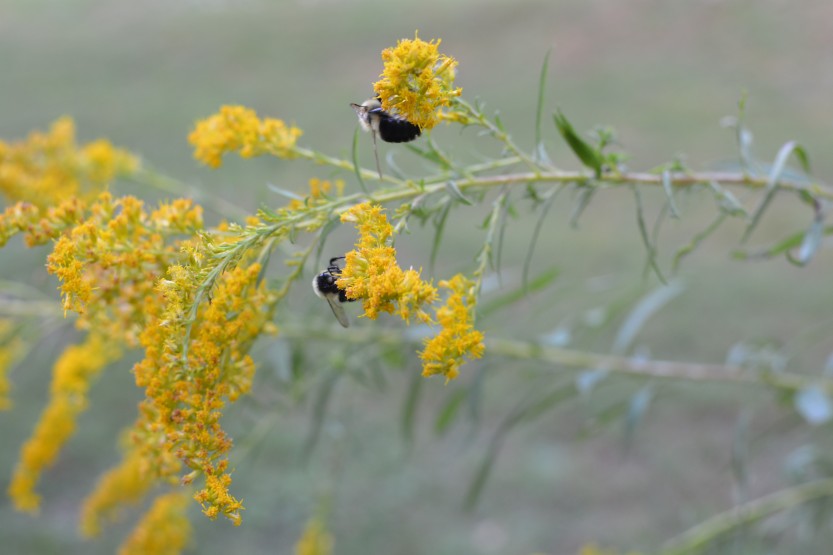
This volunteer wildflower, Goldenrod (Solidago) has moved itself entirely from one side of the garden to the other this year, and is a beautiful contrast to all my orange flowers. For next year, I am thinking of planting nothing but flowers in the garden, and I will be watching this plant closely during the coming weeks to see whether it makes seeds that I can harvest and spread to more areas for next spring. I’ve just looked it up online and learned that Goldenrod has medicinal value and that every part of the plant can be used, for teas, etc., making it a very welcome “weed” in our garden.
Once again, for more about this weekly challenge, visit The Propagator Blog for the Participant’s Guide and links to many gardener’s Six on Saturday postings each week.

What beautiful pictures. Those beautyberries are stunning.
LikeLike
Thank you!
LikeLike
Collecting seed from Solidago and spreading it around is a lot of wasted effort. Some varieties happily hang around where you plant them and don’t generally appear in the garden on their own. Others (I guess yours is one of them) do all the hard work for you and seed all over the place. So let them do the hard work and if one appears where you don’t want it, just lift it and replant where you do.
LikeLike
Usually I see a single Solidago plant in our garden each year, in one place or another. Maybe that’s because I am too aggressive a weeder earlier in the season and don’t know how to recognize the plant itself when it’s not in flower. I don’t so much want to move it, as to multiply it. Do you think it’s such a choosy plant that I won’t be able to interfere in that way? What if I purchased seeds? Sounds a little ridiculous, but I actually saw Solidago seeds online for sale. I assume they are varieties, since I read that there are more than a hundred varieties of this plant.
LikeLike
I tend to limit weeding early in the year because otherwise I’ll also be removing seedlings I want to keep. There are some exceptions but with these I’ve learned how to recognise the cotelydons.
Try Googling for “solidago seedling images” for example. The seedling leaves are a different shape to those on mature plants. Sounds like your plants come in from the wild so they are a self-seeding type. Once established they are strong plants and regrow in the spring so I’m guessing you are weeding them out.
Try this link for info on propagating – https://www.gardenershq.com/Solidago-Golden-Rod.php. Maybe sowing seed indoors will avoid you weeding out your seedlings.
LikeLike
Those beauty berries are a fabulous colour.
LikeLike
Yes, thanks! I’m considering a propagation attempt with this bush, now that I’ll have space to fill where the fig was. I’ve noticed other people growing beauty berries in full sun successfully, even though the literature says it prefers semishade. The berries would be a striking attraction in that location, which is near the street.
LikeLiked by 1 person
The bees on the solidago is wonderful. Mine is blooming as well but I’m still waiting for the asters.
LikeLike
I have two asters – the blue in my front yard which are blooming normally; and also a long row of tiny white-flowered asters out in the garden. The white ones are doing poorly this year for the first time. There was no warning. They had lots of buds. But now, very few open flowers. I’m still hopeful.
I had never photographed Solidago before and never before researched it. It may be a new favorite for me. Thanks!
LikeLike
Such a vivid purple on those Beautyberries!
LikeLiked by 1 person
Beautiful! It’s lovely reading about a garden which has different things to mine (apart from the butterflies). The beauty berry is stunning. We have also just had a month with no rain but it’s amazing how many things have coped and are still providing colour and food. Good luck with the seed plans for next year!
LikeLiked by 1 person
Thank you! Peppers are the main food I am still getting from the garden, but that’s probably because I didn’t plant much. I’m letting the few self-seeded field peas go on to seed again now. And the flowers, too.
LikeLiked by 1 person
Self-seeding (with a little tweaking here and there) is my favourite way of gardening – perhaps that makes me lazy but I think nature knows what its doing better than I do! 🙂
LikeLiked by 3 people
Hi, I like the new name and look of your blog and the pictures are lovely. One question although, where are you? Which country? Either I have missed it or it’s not clear and I’m wondering
LikeLike
I’m in the United States, in Georgia. I should fix that! Thanks!
LikeLiked by 2 people
I have added my location now in a couple of spots, hope it seems obvious enough! Thanks again!
LikeLiked by 1 person
Hi, no worries. I added my location into my blog after reading a few others and feeling lost because I couldn’t work out where they were coming from. You tend to think its obvious in your own blog, I did! Still not sure its clear every time in mine …?
LikeLike
Your garden’s still looking great, altho hard luck w/no rain. Are you in the UK – because we finally got our rain? (I thought you were.) John K gave great advice about the goldenrod. That yellow wand will turn into a brown wand of hundreds of seeds, so no need to buy any. Let us know about propagating the beauty berry bush.
LikeLiked by 1 person
I’m in the USA, and trying to update my blog to reflect that (I just never thought about it before; somehow I assumed that my location showed up somewhere!) We are supposed to get some rain sometime this week, but for the past month there has been none. Following all the weeks and weeks of steady rain earlier in the season, my poor plants just couldn’t adjust. I’m afraid my photos don’t show an honest picture of the ugliness and death; that would be too depressing. Thanks, though!
LikeLike
Hello again. I had a volunteer goldenrod show up last year. I dug it up before it could self seed, i decided i didn’t like it that much and it was crowding out nicer stuff. I’d heard it was a bit of a thug, so if I can mix my metaphors, a stitch in time saves nine! Hope to see you again soon.
LikeLiked by 1 person
I can easily see why you might not want the goldenrod taking up space in your garden. But because I’m sort of winding down my garden it seems really appropriate here, especially since I’m now planning to plant nothing but flowers there next spring. (There will always also be herbs.) In fact, I’m going back and forth about whether to buy seed for an interesting yellow-flowered plant I found on the Seedaholic site because it seems so close to the goldenrod in appearance. If I really can get the goldenrod to multiply, I might not also need this one: https://www.seedaholic.com/patrinia-scabiosifolia.html?___SID=U
LikeLike